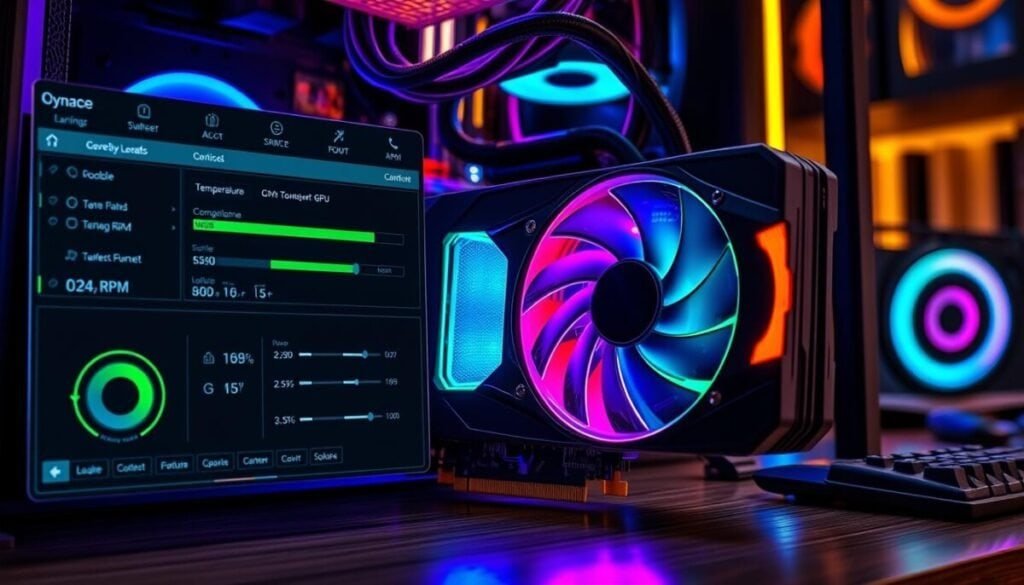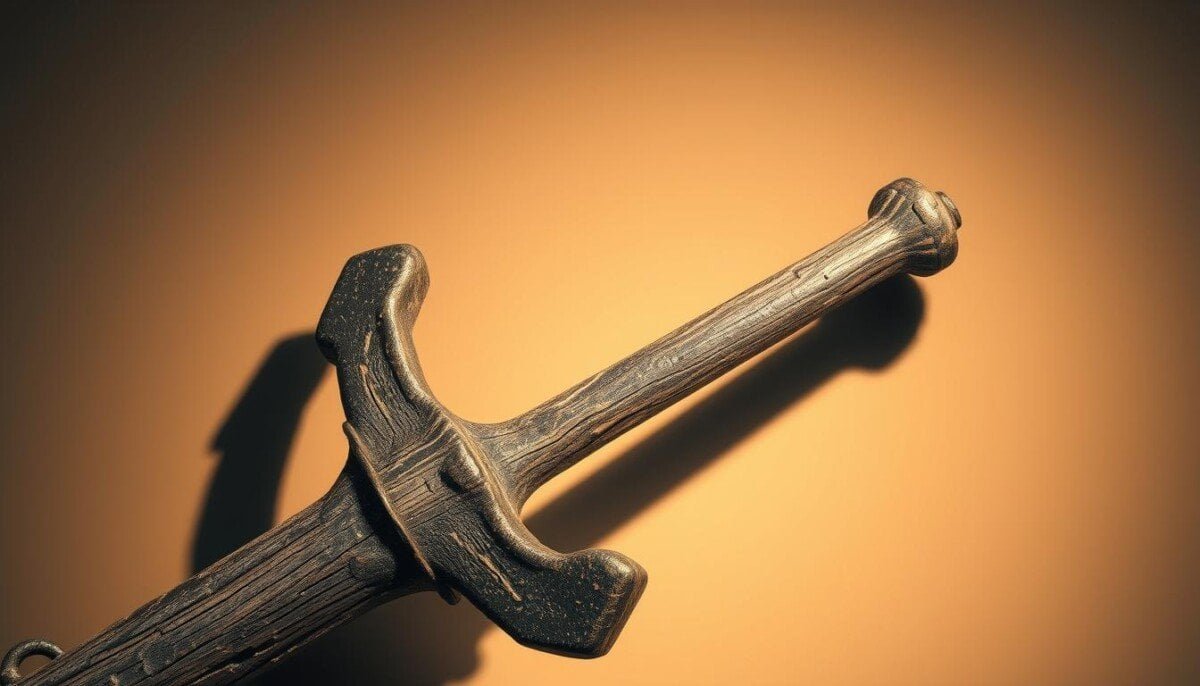Did you know over 65% of gamers and tech fans deal with graphics card fan noise? This problem can be more than annoying. It might show deeper issues that could cause overheating and damage. It’s key to fix graphics card fan noise to keep your system running well.
Knowing why fans make noise is the first step. For example, a high-pitched whine might mean everything’s okay or the bearings need attention. Clicks usually mean debris is stuck in the fan. These signs show why cleaning is so important for smooth running. If the noise doesn’t stop, you might need to replace the fan or add lubricant.
This article will help you find and fix graphics card fan noise problems. By following our tips, you can make sure your graphics card runs quietly and efficiently.
Key Takeaways
- High-pitched whines may indicate normal operation or bearing wear.
- Clicking sounds can result from debris or misaligned fan components.
- Insufficient lubrication might lead to screeching noises, suggesting a need for fan replacement.
- Humming noises are often caused by imbalanced fan blades, leading to potential replacements.
- Chattering sounds indicate loose screws or debris, best addressed through maintenance.
- Regular cleaning and maintenance are crucial in preventing fan noise issues.
- Proper fan settings adjustments can significantly reduce noise levels.
Understanding Graphics Card Fan Noise
Many gamers and PC users face the problem of graphics card fan noise. Knowing the causes helps users fix the problem. It’s important to tell if the noise is normal or a sign of trouble.
Common Causes of Fan Noise
Several things can make graphics card fans noisy:
- Dust buildup: Dust inside the computer can make fans noisy. Cleaning regularly helps.
- Dry lubricant: Fans can make grinding sounds if their lubricant dries out.
- Worn-out bearings: Worn fan bearings can make noise, showing they need oil or replacement.
- Mechanical misalignment: If fan parts are not aligned right, they can buzz or click.
Normal vs. Excessive Noise
It’s important to know what’s normal fan noise. Fans usually get louder when they work harder. For example, the VIPERA NVIDIA GeForce RTX 4090 Founders Edition might get louder when it’s hot.
But, if the noise is too loud or sounds different, like squealing, it’s a problem. You should check it out.
When to Worry About Fan Noise
Take action if fan noise is too loud or if it’s with performance problems. You should worry if:
- The noise is much louder than usual
- The graphics card overheats when it shouldn’t
- You hear strange noises like clicking or grinding
If you notice these signs, you can try lubricating the fan or get help from a pro. Knowing when to act can save your graphics card.
Identifying Fan Noise Issues
Finding out where fan noise comes from is key to fixing it. Many have had problems with fan noises, especially with the EVGA 3060 XC. By listening for specific sounds and doing a detailed check, you can solve these problems fast.
Listening for Distinctive Sounds
Listen carefully to what your graphics card sounds like. Buzzing, grinding, or clicking might mean:
- Debris caught in the fan blades.
- Misaligned fan parts.
- Wear and tear from too much use, possibly bad bearings.
Visual Inspection of the Graphics Card
Looking closely can show several problems. Check for:
- Loose parts that might vibrate.
- Dust that blocks airflow.
- Damage that could mess with fan work.
Seeing these signs helps figure out if the noise is from a mechanical problem or just dust.
Checking the Graphics Card Software
Using graphics card software, like Precision X1 or MSI Afterburner, is helpful. It lets you:
- Change fan speed settings for better performance.
- Watch fan speeds and temps to spot overheating or too much speed.
- Make custom fan curves to reduce noise when not busy.
Notice how fan noise changes with temperature. This might tell you if the sound is normal or if there’s a bigger problem.
Cleaning and Maintenance Tips
Keeping your graphics card fan quiet and working well is key. Regular cleaning and care help your GPU last longer. Here are some steps to clean your GPU right.
How to Open Your Computer Case Safely
First, turn off and unplug your computer. Look at the case manual for how to open it safely. The right tools and steps prevent damage.
Dusting Off Components
Dust can make your GPU fan work harder. Cleaning the fan and heatsinks is crucial. Use compressed air to remove dust well. This stops dust from making noise later.
Using Appropriate Cleaning Tools
Choose the right cleaning tools. Here are some good ones:
- Compressed air
- Lint-free cloth
- Isopropyl alcohol (70-75% concentration)
These tools clean your GPU well without harm. If you need to lubricate, use a little. Be careful not to use too much. These tools clean your GPU well without harm. If you need to lubricate, use a little. Be careful not to use too much. Additionally, always ensure the GPU is properly reassembled to avoid operational glitches. For more complex concerns, such as identity verification issue fixes during software updates or driver installations, consult the manufacturer’s support team. Proper maintenance and attention to detail can greatly extend your GPU’s lifespan and performance.
Post-Cleaning Care
Let the GPU dry completely before putting it back. This stops moisture problems. After putting it back, plug it in and test it. Regular cleaning keeps your GPU running smoothly and quiet.
| Cleaning Procedure | Tools Required | Notes |
|---|---|---|
| Initial Setup | Computer manual | Power off and unplug your device |
| Dust Removal | Compressed air | Focus on fans and heatsinks |
| Surface Cleaning | Lint-free cloth, Isopropyl alcohol | Use for non-electronic surfaces |
| GPU Fan Lubrication | Appropriate lubricant | Apply sparingly |
| Post-Cleaning Testing | Power cord | Ensure functionality before full use |
By following these tips, your graphics card will work better and last longer. Regular care keeps the fan quiet and your computer comfortable.
Adjusting Fan Settings
Proper fan settings can make your gaming better by being quieter and cooler. There are many ways to adjust fan settings, like BIOS/UEFI and special software. Knowing how to use these tools is key to finding the perfect balance.
Accessing BIOS/UEFI Settings
To start, you need to get into your motherboard’s BIOS or UEFI settings. Here, you can set fan profiles based on temperature. For example, ASUS motherboards let you control GPU fan speeds. Changing these settings helps make your system quieter and more efficient.
Using Graphics Card Software for Fan Control
Companies like ASUS and MSI offer software for controlling GPU fan speeds. Tools like MSI Afterburner let you adjust fan curves manually. You can set fan speeds or create curves for different loads. Tools like HWMonitor help check if these changes work well.
Setting Optimal Fan Speed Profiles
Finding the best fan speed is about cooling and quietness. A good starting point is 60% to 70% fan speed. This lets you adjust to your liking. ASUS ROG or TUF cards have special controls for side and center fans.
Creating fan profiles that turn fans off at low temperatures is a good idea. This makes your system quieter during everyday use. Adjusting settings like Power Target and GPU Temp Target can also help manage noise and efficiency.

Upgrading or Replacing Fans
If fans keep causing problems, it’s time to think about upgrading or replacing them. It’s important to pick fans that fit well and cool well. This ensures your GPU stays cool.
Best Practices for Choosing Replacement Fans
When picking new fans, consider a few things:
- Size and Dimensions: Make sure they match your GPU.
- Airflow and Static Pressure: Choose fans with high airflow for better cooling.
- Noise Levels: Opt for quiet fans, especially if you game a lot.
- Brand Reliability: Go for well-known brands for quality and durability.
Installing New Fans Safely
Installing fans right is key to avoid damage:
- Ground Yourself: Use an anti-static wrist strap to prevent static.
- Disconnect Power: Unplug your PC before starting.
- Follow Guidelines: Stick to the manufacturer’s instructions for mounting and connecting.
- Test Functionality: Turn on your system to check if fans work right after installation.
Alternative Cooling Solutions
If fans alone don’t solve the problem, look into other cooling options:
- Liquid Cooling: Offers better performance and is often quieter.
- Passive Cooling: Uses heat sinks that work without fans in low-power situations.
- Hybrid Solutions: Mixes air and liquid cooling for the best results.
Preventing Future Fan Noise
Reducing fan noise is key for a quiet gaming setup. Start by cleaning and checking your computer parts regularly. This helps stop fans from getting too hot and making noise.
Regular Maintenance Schedule
Make cleaning a part of your routine. Clean your computer every few months. Use canned air to dust off CPU and GPU fans for better airflow.
A clean system runs smoothly. It should use less than 20% CPU when idle. This means no programs are using too much power.
Monitoring System Temperature
Watch your system’s temperature, especially when gaming hard. Use software to check if fans are working right. If CPU usage jumps, it might be a game or malware.
Also, tweak fan settings in BIOS or software to keep noise down.
Tips for Silent Graphic Cards Options
Look for graphics cards with quiet cooling. Check the airflow (CFM) and noise (dBA) specs of fans. For even less noise, try CPU coolers instead of fans.
By following these tips, you can keep your system quiet and cool.



